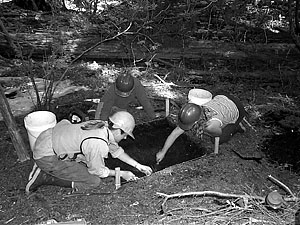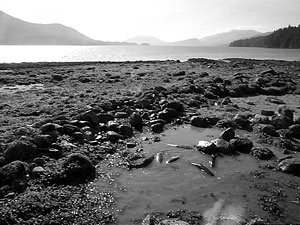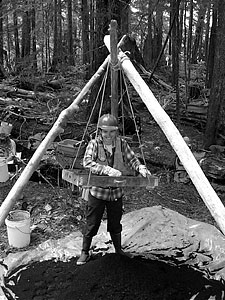 April is Alaska Archeology Month April 06, 2005
Wrangell Ranger District archeologist Jane Smith recently hosted a Passport In Time (PIT) project that allowed volunteers a chance to help record a bit of Etolin Island history. Working in remote areas, archaeologists and PIT volunteers visited a variety of sites including wood stake and stone fish traps, camps, villages, cabins, and an abandoned cannery. The most common archaeology sites on Etolin Island are well-disguised ancient camps and villages buried below the forest floor. We know of 22 shell midden sites on the island, ranging in size from small, limited use camps to large villages. Shell middens are an accumulation of shell, bone, ash, and charcoal that represent the discarded byproducts of a traditional subsistence lifestyle. Investigations on south Etolin revealed a large village - called Giant Spruce Midden - that may have been home to a hundred or more people. The team excavated a test unit by carefully peeling back each layer of accumulated soil. All the soil was sifted through screens and artifacts were collected, each layer separate from the next. Charcoal from two of the layers yielded radiocarbon dates of 1,550 years B.P. (before present) and 1,990 years B.P., although other evidence suggests the site is older. Recovered animal bones included river otter, mink, cod, rockfish, and salmon. Rockfish specimens outnumber all other species, which is noteworthy since ethnographic accounts generally point towards salmon as the main subsistence resource in the region. Fish traps and weirs are common to Etolin Island and across the region. Wood stake fish traps are often intertidal and were once fence-like structures now identifiable by small nubs of wood protruding above mucky tidal sediments.
Stone traps and weirs are often higher up on the tide flats and set off to one side of the stream mouth. They are commonly made by piling rocks to form broad arcs that trap fish behind them as the tide recedes. Tongass archeologists know of 13 ancient fish trap sites on Etolin, all of which are somewhat unique in design and function. Three of the sites have been radiocarbon dated between 1,480 years B.P. and 1,740 years B.P., an age when fish traps across southeast Alaska were rather common. Tongass archaeologists have
recorded almost 250 trap and weir sites across the Forest. The
abundance of large tidal traps, intended to harvest mass quantities
of fish, suggests relatively high population levels and a complex
social structure. Whether all the traps targeted salmon or other
species remains in question. The Tongass archaeologists welcome help from the general public and offers Passport in Time projects every summer. Past Tongass PIT projects have included site excavations, recording of rock art sites, and archival research. Because PIT is a volunteer program there is no cost to participate. Volunteers are responsible for transportation to and from Alaska. If you'd like more information about Passport In Time check out their web site at www.passportintime.com.
Story and photographs courtesy United States Forest Service - Tongass National Forest.
|
|||


